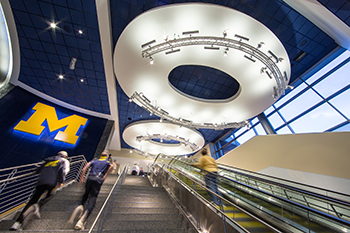MEP & Architectural Coordination for Athletic Facilities
 Athletic facilities are places to gather and enjoy a favorite team or sporting event. Today, large, successful, collegiate and professional athletic facilities are being designed with a “wow” factor in mind and the intention to draw large crowds. This requires that the building’s infrastructure be carefully sized and coordinated with the architecture.
Athletic facilities are places to gather and enjoy a favorite team or sporting event. Today, large, successful, collegiate and professional athletic facilities are being designed with a “wow” factor in mind and the intention to draw large crowds. This requires that the building’s infrastructure be carefully sized and coordinated with the architecture.
Designing building systems for a new or renovated athletic facility can be a serious challenge for engineers and architects. Creating a comfortable, aesthetically pleasing venue with high-priced spaces and special architectural features requires creativity and meticulous coordination.
Peter Basso Associates of Troy, Mich., recently completed MEP (mechanical, electrical, plumbing) engineering and lighting design for the 12,700-capacity University of Michigan Crisler Arena expansion in Ann Arbor, Mich., dividing it into general purpose, finished spaces and arena space. General purpose includes mechanical and electrical rooms, toilet rooms and maintenance spaces, whereas finished spaces comprise suites, alumni clubs and offices. Arena space includes the athletic court areas and spectator seating. This article focuses on the coordination of general purpose and finished spaces, examining equipment location, accessibility requirements, allocated above-ceiling space, ductwork and pipe pathways.
The first step in the coordination process is to gain a thorough understanding of the building type, function and desired atmosphere. Before the expansion, temperatures inside the Crisler Arena fluctuated from cold to frigid. The facility was poorly lit and largely uninviting. One design goal was to reinvigorate inside and outside spaces using vibrant team colors.
The building’s circular configuration was an added challenge. Designers were tasked with creating a new main entrance that would grab spectators’ attention but keep the existing aesthetics intact.
The team also developed new concepts for pedestrian circulation and discussed incorporating new architectural features. Design engineers then met with building operators to gain a sense of its functionality, usage and time of occupancy. For example, would the building be operational 24/7, 365 days a year, or would the building sit “dark” for periods at a time?
Maintenance staff indicated what special and preferred systems would be needed in order to complete daily operations. From there, design engineers made energy-efficient recommendations that were satisfactory to the architectural partners and met maintenance staff needs, all while staying under budget. Then, the mechanical and electrical systems were selected and the design phase commenced.
In selecting the location of mechanical and electrical spaces, a few items were taken into consideration: the type of structure in and around each room, proximity to the exterior, utilities being provided and accessibility. Since the preferred locations were along the exterior where the structure tended to be the largest, pathways for ductwork, piping and electrical conduits were identified within the existing structure and adjacent spaces so no additional floor space would be required. However, retaining space despite infrastructure improvements proved to be yet another challenge.
 The owner noted that all existing spaces served a valuable purpose that could not be compromised. Once rooms were established along the exterior, utilities were coordinated with the civil engineer and utility providers. Equipment inside the mechanical and electrical rooms was located, and service clearances and pathways for replacement were incorporated into the floor plans.
The owner noted that all existing spaces served a valuable purpose that could not be compromised. Once rooms were established along the exterior, utilities were coordinated with the civil engineer and utility providers. Equipment inside the mechanical and electrical rooms was located, and service clearances and pathways for replacement were incorporated into the floor plans.
An understanding of how the space would be used was critical. For example, light switches, receptacles and thermostats could not interfere with custom wall coverings. Additionally, the ceiling space above the club area was crowded with mechanical and electrical services; some fed the club while others passed through to adjacent spaces. Coordinating the services was critical in avoiding interference. The design engineers took a close look at each structural member, conduit, light fixture and depth, ductwork, piping and hanger configuration. This detailed approach helped establish the desired ceiling height, but also ensured accessibility for the maintenance staff.
The biggest challenge for design engineers in large sporting venues such the Crisler Arena is not the complexity of the mechanical electrical systems, but the detailed coordination required between the different disciplines. Each discipline brings a different design solution to the table and they must all be understood to ensure a successful project. By understanding different design solutions and how they relate to building operations, the design engineer can provide an efficient, fully coordinated system that will meet end-user needs for decades to come.
David A. Conrad, PE, is a senior associate mechanical engineer at Peter Basso Associates Inc., with 15 years of design engineering experience. He specializes in recreation, government and higher education design.
Camille Sylvain Thompson is a marketing communications coordinator at Peter Basso Associates Inc., with 15 years of experience in communications and marketing for the A/E/C industry.
